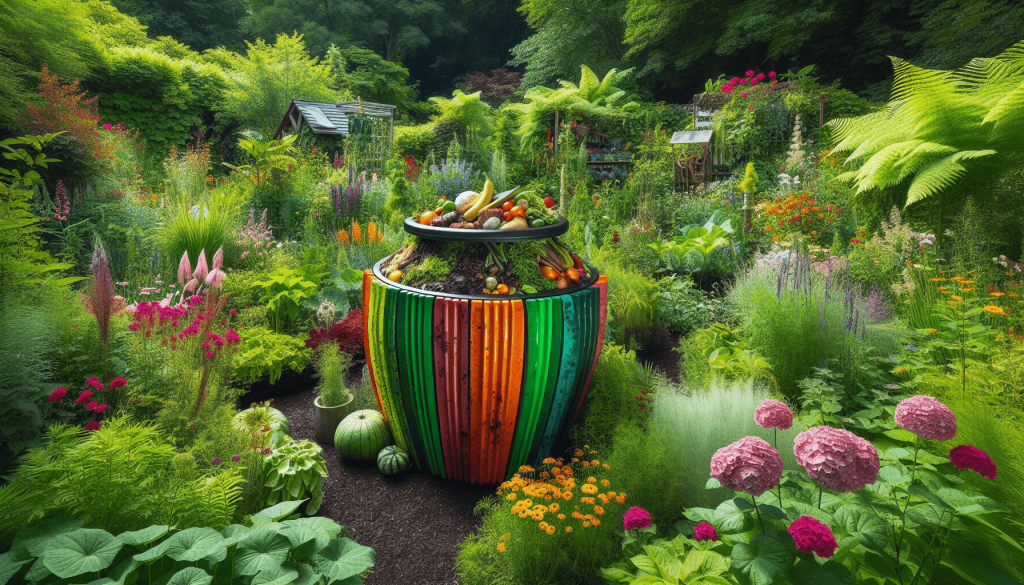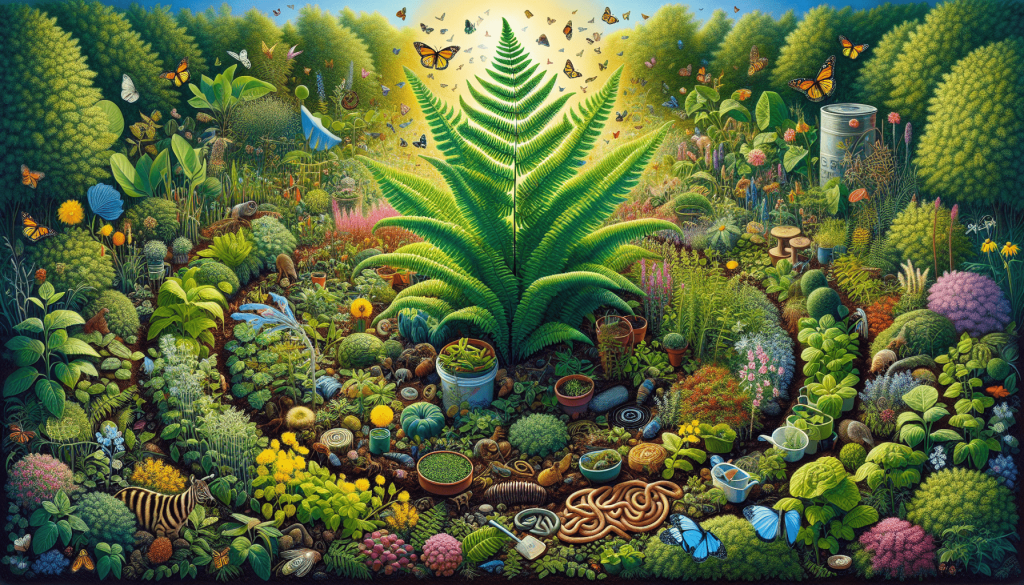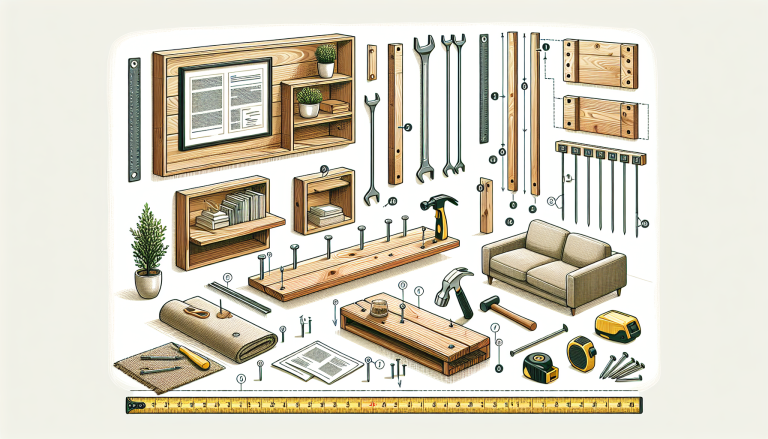Picture this: you step outside into your backyard, feeling the warmth of the sun on your face as a gentle breeze rustles through the leaves of the trees. As you take a deep breath, you’re instantly greeted by the sweet scent of blooming flowers and the sound of buzzing bees. This is the garden you’ve always dreamed of – a lush, vibrant oasis that not only provides you with an abundance of fresh fruits and vegetables, but also works in harmony with nature. In this article, we’ll explore the fascinating world of sustainable and permaculture gardening, and discover how you can design your very own garden paradise that is not only beautiful, but also eco-friendly.
Table of Contents
ToggleChoosing the Right Location
Consider the Climate and Microclimate
When designing a garden with a sustainable and permaculture approach, it is essential to consider the climate and microclimate of your location. The climate of an area greatly affects what plants can thrive there. Take note of the average temperatures, rainfall patterns, and overall weather conditions throughout the year.
In addition to the general climate, it’s crucial to understand the microclimate of your specific garden site. Microclimates are small-scale variations in climate that are influenced by factors such as sunlight exposure, wind patterns, and the surrounding landscape. Assessing the microclimate will help you determine which areas of your garden receive the most sunlight, shade, and wind, allowing you to make informed decisions about plant placement and water management.
Assess the Sun Exposure
Sun exposure is a crucial factor to consider when designing a sustainable garden. Different plants have varying sunlight requirements, so it is important to assess the sun exposure in your garden before selecting the plants you want to grow.
Observe how the sun moves across your garden throughout the day and note which areas receive full sun, partial shade, or full shade. Keep in mind that the sun’s angles and intensity can change throughout the seasons, so it’s important to consider these variations when planning your garden layout.
By understanding the sun exposure in your garden, you can strategically place plants that require more sunlight in the sunniest areas and those that prefer shade in the shadier spots. This way, you optimize the growth and health of your plants while minimizing water and energy usage.
Analyze the Soil Quality
The soil quality in your garden is the foundation for healthy plant growth. It’s important to analyze the composition and characteristics of your soil to determine its fertility, drainage, and nutrient content.
One way to assess your soil quality is by conducting a simple soil test. Soil testing kits are available at most garden centers or can be done through a soil testing laboratory. These tests measure important factors such as pH levels, nutrient content, and organic matter. Based on the results, you can determine any necessary amendments or improvements to optimize the soil for plant growth.
Additionally, consider the texture and structure of your soil. Different plants have varying soil requirements, so understanding the composition of your soil will help you choose appropriate plants that can thrive in your garden.
Water Management
Install a Rainwater Harvesting System
Water is a precious resource, and using it efficiently is vital in sustainable garden design. One way to maximize water conservation is by installing a rainwater harvesting system. This system collects and stores rainwater from your roof, which can then be used to water your garden.
Rainwater harvesting systems come in various forms, such as rain barrels or larger tanks with filtration systems. By capturing rainwater, you reduce the strain on municipal water supplies and save on your water bill. Additionally, rainwater is free from chemicals such as chlorine, making it healthier for your plants.
Utilize Drip Irrigation
Drip irrigation is an efficient watering method that delivers water directly to the plant’s roots, minimizing water wastage through evaporation and runoff. It is a sustainable alternative to traditional watering methods like sprinklers.
Drip irrigation systems can be set on timers or operated manually, allowing you to control the amount and frequency of water your plants receive. By providing water directly to the roots, you can ensure that each plant receives the necessary moisture without excess water being lost to evaporation or absorbed by surrounding weeds.
Implement Mulching Techniques
Mulching is an essential practice in sustainable garden design as it helps to conserve water, suppress weed growth, and improve soil health. Mulch acts as a protective layer on top of the soil, reducing moisture loss through evaporation and preventing weeds from taking root.
Organic materials such as wood chips, straw, or compost can be used as mulch. These materials gradually break down, adding organic matter to the soil and improving its fertility. Additionally, mulch moderates soil temperature, keeping it cooler in hot weather and warmer in colder months.
By implementing mulching techniques, you can improve water efficiency, reduce the need for irrigation, and enhance the overall health of your garden.
Plant Selection
Opt for Native and Adapted Species
Selecting native and adapted plant species for your garden is a sustainable choice that promotes biodiversity and resilience. Native plants are those that naturally occur in the region and have adapted to local climate conditions, soil types, and wildlife interactions.
These plants have evolved alongside native pollinators and wildlife, providing essential habitat and food sources. By incorporating native plants into your garden, you create a symbiotic relationship with the local ecosystem, supporting the conservation of native species and promoting biodiversity.
Adapted species, on the other hand, are non-native plants that have proven to be well-suited to the local climate and growing conditions. These plants, although not native, can still provide ecological benefits and reduce the need for excessive water, fertilizers, and pesticides.
Choose Perennial Plants
In a sustainable garden design, perennial plants play a crucial role in creating a low-maintenance and long-lasting landscape. Perennials are plants that live for multiple years, as opposed to annuals, which complete their life cycle within one year.
By incorporating perennial plants into your garden, you reduce the need for replanting each year and minimize soil disturbance. Perennials tend to have deeper root systems, which improves soil structure, reduces erosion, and increases water infiltration. These plants also provide year-round interest with their foliage, flowers, and seedheads while supporting pollinators and beneficial insects.
Integrate Companion Planting
Companion planting is a sustainable gardening technique that involves planting different species together to enhance growth, repel pests, and improve overall plant health. When certain plants are placed near each other, they can have beneficial interactions that help deter pests, improve nutrient uptake, and increase pollination.
For example, planting marigolds near tomatoes can help repel nematodes, while growing basil near peppers can enhance their flavor and repel aphids. By carefully selecting companion plants, you can create a balanced and resilient garden ecosystem that reduces the need for chemical pesticides and fertilizers.
Creating Biodiversity
Incorporate a Variety of Plants
In a sustainable garden design, biodiversity is key to creating a resilient and thriving ecosystem. By incorporating a wide variety of plants, you provide habitat and food sources for a diverse range of insects, birds, and other wildlife.
Include plants with different heights, shapes, and blooming periods to accommodate various pollinators and beneficial insects throughout the year. Native plants, in particular, attract a diverse array of wildlife and support the local ecosystem.
Additionally, consider incorporating plants that provide food for birds, such as berries or seeds, and those that offer shelter, such as evergreen trees or dense shrubs. These elements contribute to the overall biodiversity of your garden and create a welcoming environment for wildlife.
Build Habitats for Wildlife
To further enhance biodiversity, consider creating specific habitats for wildlife within your garden. Install birdhouses, bat boxes, and butterfly houses to provide shelter and nesting sites. Add a variety of native plants that produce fruits, nuts, or seeds to attract birds and small mammals.
Incorporate features such as rock piles or log piles to create hiding spots and homes for insects, reptiles, and amphibians. These habitats not only provide a safe haven for wildlife but also contribute to a healthy and balanced garden ecosystem.
Include a Pond or Water Feature
Adding a pond or water feature to your garden can greatly enhance biodiversity and act as a focal point for both wildlife and human enjoyment. Ponds provide a water source for birds, insects, and other animals while supporting aquatic plant life.
A well-designed pond should include shallow areas for animals to access the water, as well as marginal planting zones consisting of aquatic plants like water lilies, rushes, or irises. Incorporate rocks and logs to create places for animals to rest and bask in the sun.
Water features can also provide a sense of tranquility and aesthetics to your garden, enhancing the overall experience for both you and the wildlife that visit.
Soil Improvement
Add Organic Matter
Improving soil health is essential in sustainable garden design, and adding organic matter is one of the most effective ways to achieve this. Organic matter includes materials such as compost, leaf litter, and well-rotted manure, which provide nutrients, improve soil structure, and promote beneficial microbial activity.
Incorporate organic matter into the soil by mixing it in during bed preparation or by top-dressing around existing plants. This helps to replenish nutrients, retain moisture, and enhance the overall fertility of the soil. Organic matter also aids in moisture retention, reducing the need for frequent irrigation and water wastage.
Practice Composting
Composting is a simple and effective way to reduce waste, recycle organic materials, and create nutrient-rich soil amendments. By composting kitchen scraps, yard waste, and other organic matter, you can produce a valuable resource to enrich your garden soil.
To start composting, designate a compost bin or pile in your garden. Add a mix of “green” materials (such as fruit and vegetable scraps, grass clippings, and coffee grounds) and “brown” materials (such as leaves, straw, and shredded paper). Turn the compost regularly to provide oxygen and aid in decomposition.
Over time, the organic matter will break down into nutrient-rich compost that can be used as a natural fertilizer and soil amendment. Composting not only benefits your garden but also reduces the amount of waste sent to landfills, contributing to a more sustainable environment.
Apply Natural Fertilizers
Instead of relying on synthetic fertilizers, which can have detrimental effects on soil health and water quality, opt for natural fertilizers in your sustainable garden design. Natural fertilizers include materials such as compost, manure, bone meal, and seaweed extracts.
These organic fertilizers provide a slow-release of nutrients to the soil, supporting plant growth and improving overall soil fertility. Natural fertilizers also contribute to the long-term health of the soil, promoting beneficial microbial activity and reducing the risk of nutrient runoff.
When applying natural fertilizers, follow the recommended application rates and timing for each specific nutrient source. This ensures that your plants receive the necessary nutrients while minimizing potential negative impacts on the environment.
Reducing Waste and Recycling
Implement a Composting System
As mentioned earlier, composting is a valuable technique to reduce waste and recycle organic materials. By implementing a composting system in your garden, you can divert kitchen scraps, yard waste, and other organic matter from the landfill, thereby reducing your environmental impact.
Designate a compost bin or pile in your garden and educate yourself on what materials can and cannot be composted. By separating organic waste from your regular trash, you not only reduce waste but also create nutrient-rich compost that can be used to improve your garden’s soil fertility.
Reuse and Repurpose Materials
In a sustainable garden design, it’s important to minimize waste and resources. Look for opportunities to reuse or repurpose materials in your garden rather than purchasing new items.
For example, old pallets can be transformed into raised beds or vertical planters, while broken clay pots can be used as drainage layers in container gardens. Get creative and think outside the box when it comes to repurposing items in your garden.
Reuse water from activities like washing vegetables or collecting rainwater in a bucket. This water can be reused to water your plants instead of letting it go down the drain. By finding inventive ways to repurpose materials, you reduce waste and minimize your environmental footprint.
Limit the Use of Synthetic Products
To maintain a sustainable and eco-friendly garden, it’s important to limit the use of synthetic products. These include chemical pesticides, herbicides, and fertilizers, which can have negative effects on soil health, water quality, and wildlife.
Instead, opt for organic and natural alternatives whenever possible. Look for pest control methods that rely on biological controls, such as beneficial insects or nematodes, to manage pests without the use of harmful chemicals.
When it comes to fertilizers, choose natural options like compost, manure, or organic fertilizers specifically formulated for sustainable gardening. By reducing reliance on synthetics, you create a healthier and more sustainable garden environment.
Pest and Disease Control
Encourage Beneficial Insects
In a sustainable garden, it’s essential to cultivate a healthy balance of pests and beneficial insects. Beneficial insects, such as ladybugs, lacewings, and parasitic wasps, help control pest populations naturally without the need for pesticides.
To encourage beneficial insects, incorporate diverse plantings that provide nectar, pollen, and alternate host plants. Avoid using broad-spectrum pesticides that can harm beneficial insects and disrupt the ecological balance in your garden.
By creating a welcoming habitat for beneficial insects, you can reduce the reliance on chemical pest control methods and maintain a naturally balanced garden ecosystem.
Practice Integrated Pest Management
Integrated Pest Management (IPM) is an effective and environmentally friendly approach to pest control in a sustainable garden. IPM involves a combination of proactive strategies, such as regular monitoring, cultural practices, and biological controls, to prevent and manage pests.
Regularly inspect plants for signs of pests or disease and take appropriate action at the earliest stage. This can include techniques such as handpicking pests, introducing beneficial insects, or using organic pest control methods when necessary.
Cultural practices, such as proper plant spacing, good sanitation, and crop rotation, can also help reduce pest populations and prevent the spread of diseases. By implementing an integrated approach to pest management, you can minimize the use of synthetic chemicals while effectively managing pests in your garden.
Use Organic Pest Control Methods
When pests become problematic, organic pest control methods can be employed to manage infestations while minimizing harm to the environment. There are several organic pest control options available, including homemade remedies and commercially available products.
For example, soap sprays made from a mixture of water and biodegradable soap can help control aphids, while neem oil acts as a natural insect repellent and fungicide. Diatomaceous earth, a natural substance made from fossilized remains of diatoms, can be used to control crawling insects such as slugs or snails.
Before using any organic pest control method, carefully read and follow the instructions provided. By choosing organic alternatives, you can effectively manage pests while maintaining a sustainable and environmentally friendly garden.
Maintenance and Care
Regularly Weed and Prune Plants
Regular maintenance and care are essential for a successful sustainable garden. Weeding and pruning are two important tasks that help keep your garden healthy and prevent the spread of pests and diseases.
Weeds compete with your plants for water, nutrients, and sunlight, so it’s crucial to regularly remove them from your garden. Hand-pulling weeds or using a hoe or cultivator can be effective, especially when done before weeds have a chance to set seed.
Pruning is another important practice to maintain the health and shape of your plants. Remove dead, damaged, or diseased branches to prevent the spread of disease. Pruning can also help control the size and shape of shrubs and trees, ensuring they fit harmoniously within your garden design.
Monitor and Adjust Watering
Proper watering is crucial for the health and vitality of your plants. However, it’s important to monitor and adjust your watering practices based on the specific needs of your garden.
Regularly check the moisture levels of the soil to determine if watering is necessary. This can be done by sticking your finger into the soil or using a moisture meter. Water thoroughly and deeply to encourage deep root growth, which improves plant resilience and reduces water requirements.
Keep in mind that environmental conditions, such as temperature and rainfall, can affect the water needs of your plants. Adjust your watering schedule accordingly to avoid overwatering or underwatering.
Apply Organic Pest Control as Needed
While proactive strategies like companion planting and beneficial insect encouragement can help minimize pest issues, it’s important to be prepared to apply organic pest control methods when necessary.
Monitor your plants regularly for signs of pest infestations and take action at the earliest stage. Apply organic pest control methods, such as soap sprays or neem oil, according to the instructions provided. Be sure to target only the affected plants, as indiscriminate spraying can harm beneficial insects or pollinators.
By promptly addressing pest issues and using organic pest control methods, you can effectively manage pests while promoting a healthy and sustainable garden environment.
Education and Community Engagement
Host Workshops and Events
One of the most effective ways to promote sustainable gardening practices is through education and community engagement. Host workshops and events in your garden to share knowledge and skills with others who are interested in sustainable gardening.
Offer hands-on workshops on topics such as composting, rainwater harvesting, or organic pest control. Provide demonstrations on various gardening techniques, such as planting, mulching, or pruning. Encourage participants to ask questions and share their own experiences to foster a sense of community and learning.
By sharing your expertise and helping others develop sustainable gardening skills, you can inspire and empower individuals to make a positive impact on the environment.
Share Knowledge and Tips
In addition to hosting workshops and events, sharing knowledge and tips through various mediums can reach a wider audience and inspire more people to embrace sustainable gardening practices.
Start a blog or create social media accounts dedicated to sustainable gardening. Share informative articles, practical tips, and inspiring stories that showcase the benefits of sustainable gardening. Engage with your audience by answering questions, providing guidance, and fostering a sense of community among like-minded gardeners.
Consider collaborating with local gardening organizations, nature centers, or schools to share your knowledge and expertise. Offer to give presentations, contribute articles to newsletters or magazines, and participate in panel discussions or community forums.
By actively sharing your knowledge and experiences, you can inspire others to adopt sustainable gardening practices and create a positive change in their own gardens and communities.
Collaborate with Local Organizations
Collaborating with local organizations dedicated to sustainability and conservation can greatly amplify the impact of your sustainable garden. Seek out partnerships with organizations such as environmental nonprofits, schools, community gardens, or city councils.
By collaborating, you can pool resources, share knowledge, and work towards a common goal of promoting sustainable gardening practices. Partnering with local organizations can also provide opportunities for funding, additional educational programs, and increased community engagement.
Consider participating in community events, festivals, or farmers’ markets to showcase your sustainable garden and share information with the public. By actively engaging with your community, you can foster a sense of environmental stewardship and inspire others to embrace sustainable gardening practices.
Evaluating Progress and Adaptation
Monitor Plant Health and Growth
Evaluating the progress of your sustainable garden is essential to ensure its long-term success. Regularly monitor the health and growth of your plants to identify any issues or potential improvements.
Observe for signs of pest damage, nutrient deficiencies, or diseases and take appropriate action to address these issues. Keep track of plant growth rates, flowering periods, and overall vitality to assess the success of your garden design and plant selections.
By monitoring plant health and growth, you can make informed decisions about necessary adjustments, such as plant relocation, soil amendments, or changes in watering practices. This ongoing evaluation allows you to adapt and improve your garden over time.
Assess Water Usage and Conservation
Water usage and conservation are critical aspects of sustainable gardening. Assessing how much water your garden consumes and finding ways to improve water conservation can help reduce your environmental impact.
Monitor your water usage by keeping track of watering schedules and amounts. Measure how much water you collect from rainwater harvesting systems and compare it to your garden’s needs. This evaluation allows you to determine if any adjustments are necessary to ensure efficient water utilization.
Explore additional water-saving techniques, such as installing drip irrigation systems, using mulch, or selecting drought-tolerant plant species. With a data-driven approach, you can make informed decisions about how to maximize water conservation in your garden.
Reflect on Lessons Learned
As with any garden, there will always be lessons to be learned from your sustainable gardening journey. Reflecting on your experiences, successes, and challenges allows you to continually improve your garden design and practices.
Consider keeping a garden journal or record where you document observations, plant selections, and the outcomes of different gardening techniques. This journal can serve as a valuable resource for future reference and help you identify patterns or trends in your garden’s development.
Reflect on the lessons learned from your sustainable garden and use that knowledge to refine your practices, experiment with new methods, and continue to make improvements. With each growing season, you’ll gain valuable insight and expertise that will contribute to the long-term sustainability and success of your garden.
In conclusion, designing a garden with a sustainable and permaculture approach involves careful consideration of climate and microclimate, effective water management techniques, appropriate plant selection, and creating biodiversity. Enhancing soil quality, reducing waste and recycling, practicing pest and disease control, and maintaining the garden through proper care and education are also crucial aspects. By evaluating progress, adapting to changing conditions, and reflecting on lessons learned, you can continuously improve your sustainable garden and make a positive impact on the environment.








